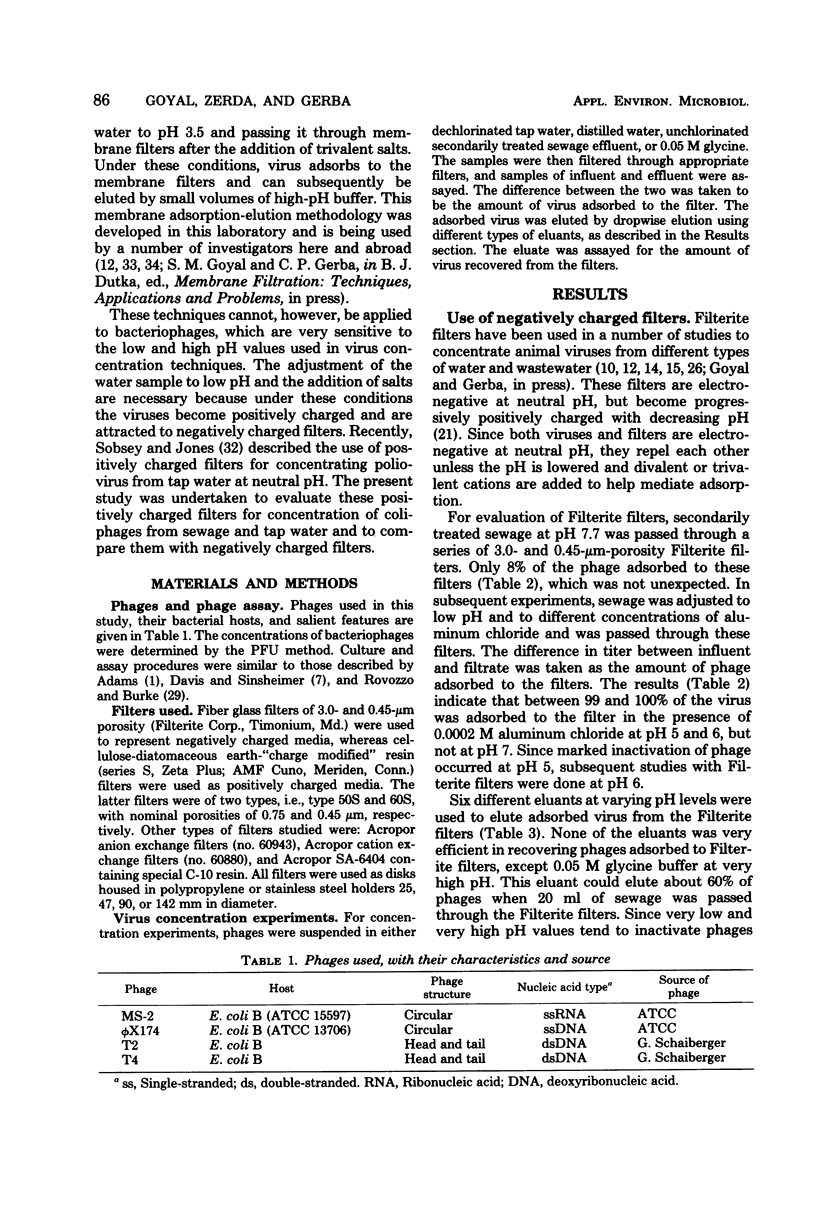Abstract
Membrane filter adsorption-elution technology has been extensively used for the concentration and detection of animal viruses from large volumes of water. This study describes the development of positively charged microporous filters (Zeta Plus) for the concentration of coliphages from large volumes of water and wastewater. Four different coliphages were studied: MS-2, phi X174, T2, and T4. Positively charged microporous filters were found to efficiently adsorb these coliphages from tap water, sewage, and lake water at neutral pH. Adsorbed viruses were eluted with a 1:1 mixture of 8% beef extract and 1 M sodium chloride at pH 9. Using this method, coliphages could be concentrated from 17-liter volumes of tap water with recoveries ranging from 34 to 100%. Coliphages occurring naturally in raw and secondarily treated sewage were recovered with average efficiencies of 56.5 and 55.0%, respectively. This method should be useful in isolation of rare phages, the ecology of phages in natural waters, and the evaluation of water quality.
Full text
PDF






Selected References
These references are in PubMed. This may not be the complete list of references from this article.
- Caroli G., Avio C. M. Isolation of mycobacteriophages from surface water. Ann Sclavo. 1975 Jul-Aug;17(4):568–570. [PubMed] [Google Scholar]
- DAVIS J. E., SINSHEIMER R. L. The replication of bacteriophage MS2. 1. Transfer of parental nucleic acid to progeny phage. J Mol Biol. 1963 Mar;6:203–207. doi: 10.1016/s0022-2836(63)80069-8. [DOI] [PubMed] [Google Scholar]
- Dhillon T. S., Chan Y. S., Sun S. M., Chau W. S. Distribution of coliphages in Hong Kong sewage. Appl Microbiol. 1970 Aug;20(2):187–191. doi: 10.1128/am.20.2.187-191.1970. [DOI] [PMC free article] [PubMed] [Google Scholar]
- Farrah S. R., Gerba C. P., Wallis C., Melnick J. L. Concentration of viruses from large volumes of tap water using pleated membrane filters. Appl Environ Microbiol. 1976 Feb;31(2):221–226. doi: 10.1128/aem.31.2.221-226.1976. [DOI] [PMC free article] [PubMed] [Google Scholar]
- Furuse K., Sakurai T., Hirashima A., Katsuki M., Ando A., Watanabe I. Distribution of ribonucleic acid coliphages in south and east Asia. Appl Environ Microbiol. 1978 Jun;35(6):995–1002. doi: 10.1128/aem.35.6.995-1002.1978. [DOI] [PMC free article] [PubMed] [Google Scholar]
- GUELIN A., GOZDA WA-LE BRIS J. Application de la recherche des bactériophages a l'étude des eaux polluées I. La survie des entérobactériacées dans les eaux. II. Bactériophages des eaux a grandes et petites plages. Ann Inst Pasteur (Paris) 1952 Jan;82(1):78–89. [PubMed] [Google Scholar]
- Gerba C. P., Farrah S. R., Goyal S. M., Wallis C., Melnick J. L. Concentration of enteroviruses from large volumes of tap water, treated sewage, and seawater. Appl Environ Microbiol. 1978 Mar;35(3):540–548. doi: 10.1128/aem.35.3.540-548.1978. [DOI] [PMC free article] [PubMed] [Google Scholar]
- Goyal S. M., Gerba C. P., Melnick J. L. Human enteroviruses in oysters and their overlying waters. Appl Environ Microbiol. 1979 Mar;37(3):572–581. doi: 10.1128/aem.37.3.572-581.1979. [DOI] [PMC free article] [PubMed] [Google Scholar]
- Hilton M. C., Stotzky G. Use of coliphages as indicators of water pollution. Can J Microbiol. 1973 Jun;19(6):747–751. doi: 10.1139/m73-120. [DOI] [PubMed] [Google Scholar]
- Jones W. D., Jr, Greenberg J. Resistance relationships in Mycobacterium smegmatis ATCC 607 to phages sensitive or resistant to both chloroform and streptomycin sulphate. J Gen Virol. 1978 Jun;39(3):555–557. doi: 10.1099/0022-1317-39-3-555. [DOI] [PubMed] [Google Scholar]
- Katzenelson E., Fattal B., Hostovesky T. Organic flocculation: an efficient second-step concentration method for the detection of viruses in tap water. Appl Environ Microbiol. 1976 Oct;32(4):638–639. doi: 10.1128/aem.32.4.638-639.1976. [DOI] [PMC free article] [PubMed] [Google Scholar]
- Loehr R. C., Schwegler D. T. Filtration method for bacteriophage detection. Appl Microbiol. 1965 Nov;13(6):1005–1009. doi: 10.1128/am.13.6.1005-1009.1965. [DOI] [PMC free article] [PubMed] [Google Scholar]
- PUCK T., SAGIK B. Virus and cell interaction with ion exchangers. J Exp Med. 1953 Jun;97(6):807–820. doi: 10.1084/jem.97.6.807. [DOI] [PMC free article] [PubMed] [Google Scholar]
- Primrose S. B., Day M. Rapid concentration of bacteriophages from aquatic habitats. J Appl Bacteriol. 1977 Jun;42(3):417–421. doi: 10.1111/j.1365-2672.1977.tb00709.x. [DOI] [PubMed] [Google Scholar]
- Seeley N. D., Primrose S. B. Concentration of bacteriophages from natural waters. J Appl Bacteriol. 1979 Feb;46(1):103–116. doi: 10.1111/j.1365-2672.1979.tb02587.x. [DOI] [PubMed] [Google Scholar]
- Sobsey M. D., Jones B. L. Concentration of poliovirus from tap water using positively charged microporous filters. Appl Environ Microbiol. 1979 Mar;37(3):588–595. doi: 10.1128/aem.37.3.588-595.1979. [DOI] [PMC free article] [PubMed] [Google Scholar]
- Wallis C., Melnick J. L. Concentration of viruses from sewage by adsorption on millipore membranes. Bull World Health Organ. 1967;36(2):219–225. [PMC free article] [PubMed] [Google Scholar]
- Zachary A. Isolation of bacteriophages of the marine bacterium Beneckea natriegens from coastal salt marshes. Appl Microbiol. 1974 May;27(5):980–982. doi: 10.1128/am.27.5.980-982.1974. [DOI] [PMC free article] [PubMed] [Google Scholar]


